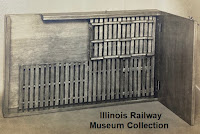The W.T. Van Dorn Company was best known for its couplers, which saw wide use in the traction industry around the turn of the century. It was also known - if someone infamously - for its "Target" steel boxcar ends, described here. However an affiliated company, formed by William Van Dorn and apparently sited on South Paulina Street alongside the W.T. Van Dorn Company, was the Van Dorn Girder Plate Company.
Among the materials recently donated to IRM by Larry Logan was a manila folder with advertising materials and some biographical information on W.T. Van Dorn himself (watch for that in a later post). The advertising materials, which are shown below, include advertisements both for boxcar ends (of the "double target" variety that came later in the 1910s and was marginally more successful than the original "Target" end) and for movable flooring for refrigerated cars. It's obvious that Van Dorn was looking for products that might expand its presence in the railroad freight car construction industry.
The collection includes several two-sided advertisements on heavy card, larger than an index card, with an illustration and brief description on one side and "selling copy" on the reverse. This card advertises Van Dorn Universal Auxiliary Flooring, basically a movable floor that you can drop into a refrigerated car. Reefers normally have slatted floors to permit air circulation but this allows you to raise the slatted floor up to the ceiling so that you can clean underneath it or use the car as a normal solid-floor boxcar. This version has all-steel framing.
If you're a cheapskate, Van Dorn will also be pleased to sell you the all-wood version, supported by 2"x4" scantlings dressed on all sides.
This fellow is showing how the floor can be raised or lowered, not to mention stopped at any intermediate point. This can be done one-handed, so don't pay any attention to the fact that the guy in the picture is using both his hands. He's just grandstanding.
There are also several advertising cards showing the "double target" end, or as it was called by the company, the Two-Piece Sectional Corrugated Steel End. "Target End" has a nicer ring to it but they didn't have much luck selling those.
This card describes the two-piece end, describes the concentric portion as an "anchor truss," and notes that the steel used is 3/16" thick plate.
This is kind of interesting. A batch of boxcars with underframes and steel ends installed, but no sides or roofs, is shown in the picture looking rather like bulkhead flat cars ahead of their time. The original Van Dorn "Target End" seemed like it was designed primarily to be retrofitted to older wooden cars, but this advertisement seems geared much more towards generating orders for new construction.
Here's an interior view, with the description pointing out that the steel car end will help stiffen and support the wooden corner posts of the body. The cars in these images were built in 1914 and it would be a few decades before all-steel boxcar construction became common. At this time, most boxcars were almost entirely wood from the floor up and single-sheathed construction with steel framing members was state-of-the-art.
And voila, the final product. This was a series of 500 cars built for the Central of Georgia and was, to my knowledge, the only large order of boxcars ever fitted with Van Dorn ends.
Finally, a peek behind the scenes at the Marketing Department. Here we see a draft for a Van Dorn advertisement including Target Ends, Two-Piece Corrugated Ends, Sectional Flooring, and Universal Auxiliary Flooring - all of the Van Dorn Girder Plate Company's greatest hits circa 1915 or so. The fun thing is that it's got corrections scribbled on it - "ventilation" and "transportation" are misspelled, the word "materially" should be dropped, a few other notations, possibly from a Mr. Cornell.
The business offices of the Van Dorn Girder Plate Company, at least at one point, were at 608 South Dearborn in Chicago. There's a large 1920s-looking office building there now but I'm not sure whether it's the same building that the Van Dorn salesmen would have recognized. Penmanship really is a dying art.



























Frank,
ReplyDeleteThe Portland #4001, the most recently restored Interurban at Western railway Museum,
has Van Dorn couplers; like IRM we also had to make up a special tow bar to move it around the shop.
Ted Miles, WRM Member